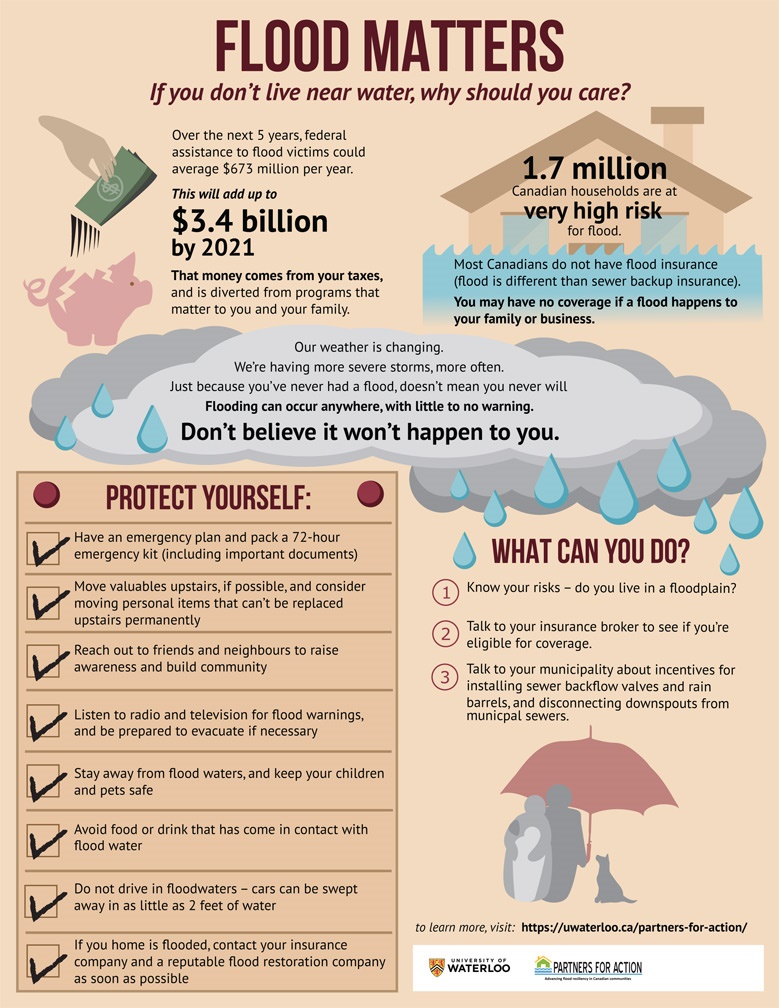In June, heavy rainfall thrust Alberta’s Bow River to record-levels, devastating swaths of downtown Calgary. The flood would later be described by the provincial government as the worst in Alberta’s history. All told, this disaster claimed five lives and inflicted $5.15 billion dollars in property damage.
One month later, the Greater Toronto Area (GTA) experienced a severe summer rainstorm and flash flood that set a record for Ontario’s most expensive natural disaster. News channels were filled with images of culverts and roadways awash, cars submerged and homes destroyed. Despite having rained for only two hours that day, estimates of insured property damage totalled more than $850 million.
Quick, forceful and without warning, many are of the opinion that these natural disasters stand as warning signs of what’s to come.
While it is true that climate change strategy has become part of the global conversation, climate action has been insufficient and slow to follow. In the meantime, sea levels will continue to rise and the frequency and magnitude of severe weather events will escalate further. Of all the dangers climate change threatens, none is more damaging and likely to occur in Canada than flooding.
The University of Waterloo’s Partners for Action (P4A) remind us why we should not disregard our potential to be impacted by flooding and provide some helpful tips on how to best “weather the storm”:
Before 1990, only three Canadian disasters exceeded $500 million in damages. In the past decade alone, nine surpassed that amount.
Recognizing the challenge, Canada launched the National Disaster Mitigation Program (NDMP) in April 2015 to address rising flood risks and costs, establishing a foundation for informed mitigation investments that could reduce, or even negate, the effects of flood events in the future.
Today, we face the question: are Canada’s largest cities prepared for future floods?
On June 15, join OSPE, Mindfirst Inc. and RBC for Global Sustainable Cities Part 2 of 3: Water, Floods and Extreme Weather, a seminar focusing on the state of preparedness of Canada’s largest cities to limit impacts relative to flood potential.
The presentation will explore why flood preparedness should extend beyond conventional areas of focus, such as flood plain mapping and urban drainage maintenance, to also include the continuity of electricity supply, communications systems, food supply, telecommunications systems, and a host of similar key city functions. Recommendations will be made regarding adaptation initiatives that are not on the radar of many large Canadian cities.
Click here to register and learn more about the presentation’s speakers and topic areas. Use promo code M1PartnerOSPE to save!
Sources:






The above article is timely and relevant. I just received a quotation from my insurance broker re: flood insurance and I do not have as much information as to why I should add another expense budget to my already long list of expense budget every month. Now it make sense for me.
The infographic says “we are having more severe storms more often”. This is untrue. The official Engineering Climate Datasets (version 2.3) – the data engineers use to design infrastructure across the country – show ‘no detectable trend signal’ in rain intensities. Environment and Climate Change Canada scientist published these results clearly in Atmosphere-Ocean in 2014:
http://www.tandfonline.com/doi/abs/10.1080/07055900.2014.969677#.V19GF7srLGI
The narrative that we are having more severe storm more often can be traced to insurance industry miscommunications that confused theoretical predictions of severe weather impacts with actual Environment Canada data. This mistake, which has been repeated by chief economists, academics, major P&C insurers, national media, civic action agencies, etc. has been very carefully exposed in the following data-driven, evidence-based review by a licensed Ontario engineer:
http://www.slideshare.net/RobertMuir3/storm-intensity-not-increasing-factual-review-of-engineering-datasets
In response to this mistake, Canada’s Advertising Standards agency has cooperated in having several major P&C insurers correct incorrect statements on rain storm intensity trends. And the CBC Ombudsman has supported the correction of inaccurate insurance industry reports in their reporting:
http://www.cityfloodmap.com/2015/10/bogus-statements-on-storms-in-cbcnewsca.html
The article in the link above was corrected following CBC’s consulting of Environment Canada.
But back to the article – thank you for highlighting the importance of managing flood risks. The infographic is confusing however in how it sets priorities: the subtitle implies that you don;t need to live by water to care about the issue but the #1 what can you do bullet asks “do you live in a floodplain”. I offer that based on the last three big floods in Toronto (I use this example as I have crunched all the data for May 2000, August 2005, and July 2013 storm), damages are NOT typically in floodplain – in fact less that 3% of reported flooding in in regulated flood vulnerable areas (typically valleys). Most flood reports are on table land, governed by unmapped, unregulated overland flow systems that adversely affect the sewer system in extreme events. This is a quantifiable using engineering principles of hydrology and hydraulics. A summary of the analysis is presented here:
http://www.slideshare.net/RobertMuir3/urban-flood-risk-from-flood-plains-to-floor-drains
So #1 should not be look for floodplain limits. That should be on the list, and readers could track down floodplains in their conservation authority jurisdiction (some not all) at this link from Conservation Ontario:
http://www.camaps.ca/
Rain barrels should not be on the list of key measures to reduce flood risks. They are great for reducing potable water use, but please do the math – no engineering study has EVER recommended these to solve a municipal flood problem – yes they are great for watershed quality and erosion objectives but that is not the topic. The math shows us that a 150 square metre rooftop draining into a half-full 0.5m3 barrel equals 1.5% of a 100 year storm runoff. Lets continue to challenge ourselves with looking for effective and cost effective solutions to flood problems.
I applaud OPSE for asking the Ontario government to step up its game on the climate and energy file. As engineers we must make sure that they, and we, stick to the facts in the climate datasets because rainfall has not followed the same ‘hockey stick’ pattern as temperature climate trends. As engineers we must also continue to step up our game on simple hydraulics and hydrology, and offer critical assessments of the panacea to flooding prevalent in media today – with a 24 hour weather channel and no 24 hour hydrology channel (can you blame them?) someone have to speak for hydrology and its us engineers.
What are the flood mitigation solutions? I would offer that it is good ‘ol fashioned design standard upgrades considering everything that we have learned in the past 40 years to mitigate urban floods risks. Here is a detailed review of that approach:
http://www.cityfloodmap.com/2016/04/design-standard-adaptation-vs-climate.html
Again, rain barrels are great for some watershed goals governed by cumulative small storm impacts, but are irrelevant to flood mitigation and big storms. Check out a few municipal Class EA’s (Cooksville Creek, Upper Hagars) or the stormwater management Infraguide on where these BMPs fit into the solution spectrum (not a core measures anywhere). Even the graddaddy of BMPs, Thomas Schueler, has intimated that BMPs may not address watershed goals for small storms, offering only lower impact development and not low impact development when deployed.
As a closing remark, the attention to climate as a driver for flood damages is obviously unfounded according to the data. Unfortunately, by promoting the insurance industry’s “Telling the Weather Story” data faux pas, as P4A has repeated in the infographic, and saying ther are more severe storms, we have enabled the data-poor, evidence-devoid energy and climate policy we are now faced with in Ontario. That is we have supported GHG mitigation as a solution as we have misdefined the problem. I can show anyone measurable increases in impervious surfaces in cities, which leads to more runoff, slowly over decades, maybe only a few percentage points each decade but it adds up over 50 years – and that simple fact is ignored in all the hype on climate and misstatements on rain frequency.
Robert Muir, P.Eng.
Toronto
We appreciate your continued interest and knowledge in this Robert – thank you for your comments. Our task forces are intrigued by all of the resources you have shared with us and will be taking a closer look at the data provided.If you’d like more information on how you can get involved in advocacy with OSPE, please reach out to us at advocacy@ospe.on.ca.
Each year it is looking more and more likely that heavy rain falls and flooding are starting to be quite common in Ontario and Quebec. For myself after this latest rain fall and flooding I will be looking into Flood Insurance . Yet another bill to budget for but I guess with it comes my sanity of knowing that I am cover in a unlikely event
Thanks for your comment Louis – you’re absolutely right, flooding is certainly an issue that many municipalities across Ontario are facing. OSPE recently released preliminary findings from our research on Ontario municipal stormwater systems.
OSPE, in partnership with Consulting Engineers of Ontario (CEO), Residential and Civil Construction Alliance of Ontario (RCCAO) and Ontario Sewer and Watermain Construction Association (OSWCA), conducted a study on the condition of stormwater infrastructure and the type of asset management planning being done in municipalities across Ontario. The survey results and subsequent recommendations are intended to guide policymakers and ensure that municipalities enjoy effective and environmentally sustainable infrastructure for years to come. If you want to learn more, stay tuned for our pending report.